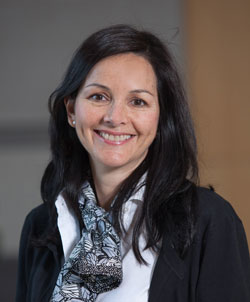 |
|
| Milagros C. Rosal, PhD |
Could an online world be as effective as face-to-face counseling to help patients control type 2 diabetes? An innovative study from UMass Medical School suggests that it can.
“Preventing and managing diabetes complications requires regular visits to primary care providers and specialists, but patient engagement is often limited by the traditional model of care, which requires face-to-face visits,” said Milagros C. Rosal, PhD. “With increasing internet use, virtual world technologies provide an alternative for delivering diabetes self-management interventions.”
Dr. Rosal, professor of medicine in the Division of Preventive and Behavioral Medicine at UMass Medical School, and John Wiecha, MD, MPH, assistant dean for academic affairs at Boston University School of Medicine, found that it is feasible to deliver a group diabetes self-management intervention to African American women with uncontrolled diabetes via an online virtual community. The study was published online Oct. 24 by JMIR Research Protocols.
“The feasibility of using this technology has not been studied with individuals who suffer the greatest diabetes disparities—socio-economically disadvantaged and ethnic and racial minorities,” said Rosal. “To our knowledge, this is the first study to compare delivering a diabetes self-management intervention via a virtual world environment compared to a traditional face-to-face format.”
African American women are among those most affected by type 2 diabetes, but many find it difficult to stick with the kind of intensive face-to-face interventions that can help them improve their diet, exercise and lifestyle habits. Cost, lack of transportation, long distances to access services and the inability to take time away from work and other responsibilities can deter even the most motivated patients from better controlling their disease.
Study participants averaged 52 years of age; 60 percent had no more than a high school education; 82 percent reported annual household income of $30,000; and had varying experience with computers. Those who were randomly assigned to the online Women in Control program created virtual representations of themselves called avatars, and interacted in online group meetings with the avatars of intervention leaders and other patients. Just like those who participated in the face-to-face group meetings, online participants were able to support each other as they received individualized guidance from the leader to make changes in diet, physical activity, blood glucose self-monitoring and medication adherence. For example, a discussion between the group leader and one patient about how to better control carbohydrate intake by reading labels at the grocery store actually visualized tossing bad choices out of a grocery cart.
Both groups achieved comparable measures for reductions in glucose levels and blood pressure. The virtual world and face-to-face interventions were both comparable in terms of fostering blood glucose self-monitoring and enhancing diabetes self-management.
Rosal and her colleagues at Boston University are planning a larger randomized controlled clinical trial of this intervention with an expanded sample of women with diabetes that includes African Americans and Latinas.
“Our initial pilot study is encouraging and we believe that virtual world technology has tremendous potential for intervening and improving